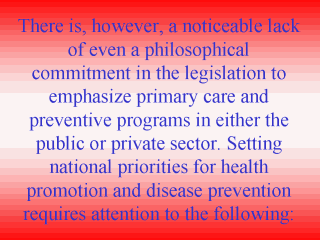| front |1 |2 |3 |4 |5 |6 |7 |8 |9 |10 |11 |12 |13 |14 |15 |16 |17 |18 |19 |20 |21 |22 |23 |24 |25 |26 |27 |28 |29 |30 |31 |32 |review |
 |
- reduction in
smoking, drug, and alcohol abuse; - improvements in nutrition and physical fitness; - control of violence, stress, accidents, and traumatic injuries; - water fluoridation and improvements in dental health; - control of infectious diseases and increase in immunizations; - preventive education about high blood pressure; - increase in family planning and maternal and child health services; - control of sexually transmitted diseases; - monitoring occupational safety and health; - control of toxins and pollutants. The issue of elucidating which factors of equity and equality in public and private health services are most cogent to enhancing population wellbeing and supporting a social safety net remains an important one for health policy and programs. |